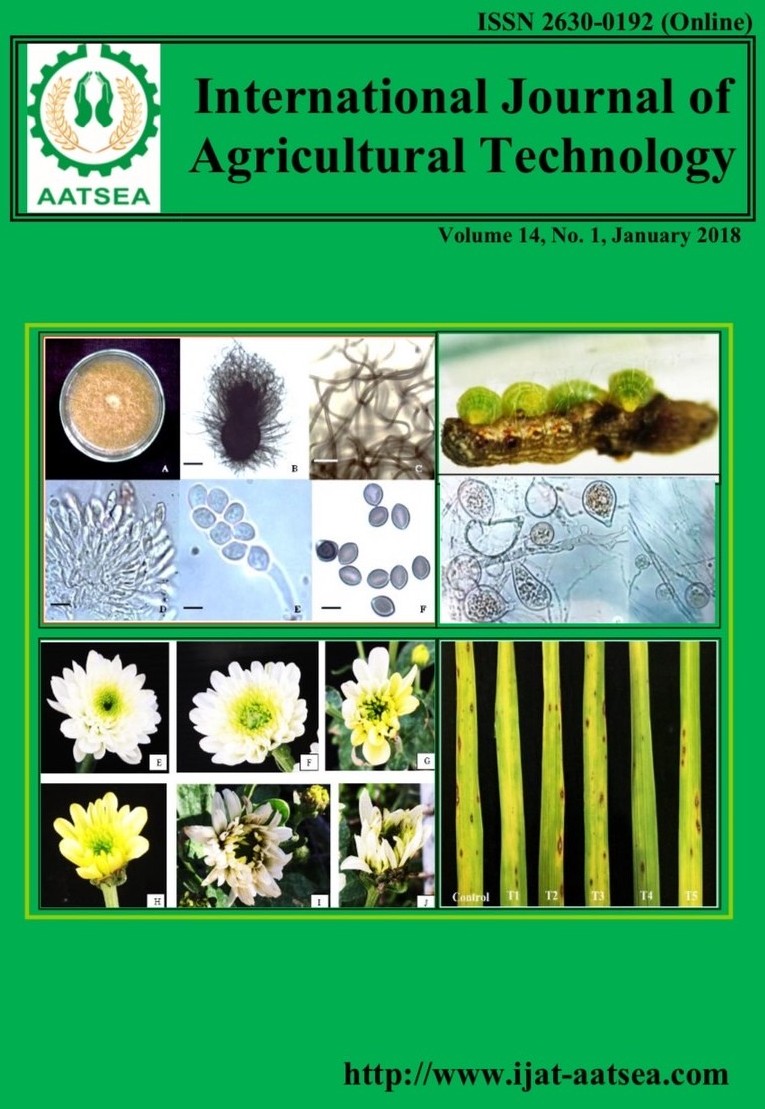Induced Mutation of Dendranthemum grandiflora through Tissue Culture by Ethyl Methanesulphonate (EMS)
Main Article Content
Abstract
The induced mutation by ethyl methasulphonate (EMS) was used for new cultivar of chrysanthemum. The calli were regenerated from immature petals of chrysanthemum (Dendranthemum grandiflora) ‘vivic’. The size of 0.5x.05 cm ray florets were cultured on Murashige and Skoog medium (MS) supplemented with 2 mg/l NAA and 4 mg/l Kinetin for inducing calli. The calli were soaked in 0, 0.5, 1.0, 1.5 and 2% EMS for60 and120 minutes to induce mutation. Afterwards, they were cultured in MS medium supplemented with 2 mg/l NAA and 4 mg/l Kinetin to induce shoots for 4 weeks. The LD50 were 1.22% EMS for 60 min and 0.72% EMS for 120 min. The shoots were regenerated from callus in control 76.67% but they could not regenerate in the EMS concentration which is higher than 1.5 mg/l. After that they were transferred to the new bottles and cultured with the same medium for every 4 weeks. All shoots regenerated the roots in the MS medium without the plant growth regulator. Rooting plants were transferd to the soil pot plants. The EMS has the efficiency to induce the in vitro mutation. There are 3 different mutations characteristic which were found in this experiment. The first were obtained in 0.5% EMS for 60 min which resulted in white stacked ray florets with 2 layers, green disk florets. The second mutation characteristic were found in 1% EMS for 60 min which the flower turned into yellow petal stacked with 2 layers, green disk florets and also the white and yellow ray florets. The last mutation characteristic of 0.5% EMS for 120 min made the ray florets slender white stacked with 2 layers and green disk florets.
Article Details

This work is licensed under a Creative Commons Attribution-NonCommercial-NoDerivatives 4.0 International License.
References
Ahloowalia, B. S. (1992). In vitro radiation induced mutants in chrysanthemum. Mutation Breeding News Letter 39:6.
Bankarat, M. N., Abdel Fattah Rania, S., Badr, M. and El-Torky M. G. (2010). In vitro culture and plant regeneration derived from ray florets of chrysanthemum morifolium. African Journal Biotechnology 9:1151-1158.
Ben Jaacov, J. and Langhans, R. W. (1972). Rapid multiplication of chrysanthemum plants by stem-tip proliferation. Horticultural Science 7:289-290.
Datta, S. K., Misra, P. and Mandal, A. K. A. (2005). In vitro mutagenesis a quick method for establishment of solid mutant in chrysanthemum. Current Science 88:155-158.
Duron, M. (1992). Induced mutations through EMS treatment after adventitious bud formation on shoot internodes of Weigela cv. Bristol ruby. ACTA Horticulturae. 320:113–118
Fang, J. Y. (2011). In vitro mutation induction of saintpaulia using ethyl methanesulfonate. Horticultural Science 46:981-984.
Kapadiya, D. B., Chawla, S. L., Patel, A. L. and Bhatt, D. (2016). Induction of variability through in vivo mutagenesis in chrysanthemum (Chrysanthemum morifolium Ramat.) var. Jaya. Indian Journal of Horticulture 73:141-144.
Khalid, N., Davey, M. R. and Power, J. B. (1989). An assessment of somaclonal variation in chrysanthemum morifolium the generation of plants of potential commercial value. Horticultural Science 38:287-294.
Latado, R. R., Adamas, A. H. and Neto, A. T. (2004). In vitro mutation of chrysanthemum (Dendranthema grandiflora Tzvelev.) with ethyl methanesulphonate (EMS) in immature floral pedicels. Plant Cell, Tissue and Organ Culture 77:103-106.
Padmadevi, K. and Jawaharlal, M. (2011). Induction of in vitro mutation in chrysanthemum (Dendranthema grandiflora Tzvelev) ray florets (var. Ravi Kiran) using gamma rays and EMS. Floriculture and Ornamental Biotechnology 5:74-77.
Samala, S., Masakee, N. and Por, N. (2014a) Effect of ethyl methanesulfonate for survival rate and stomata characteristics of in vitro chrysanthemum morifolium. Songklanakarin Journal of Plant Science 1:16-19.
Samala, S., Te-chato, S. and Yenchon, S. (2014b). Effect of ethyl methanesulphonate on Dendrobium Sonia. Khonkaen Agriculture Journal 42:506-511.
Saxena, P. K., Williams, D. and King, J. (1990). The selection of chlorsulfuron-resistant cell lines of independent origin from an embryogenic cell suspension culture of Brassica napus L. Plant Science 69:231–237.
Teixeira de Silva, J. A., Lema-Ruminska, J., Tymoszuk, A. and Kulpa, D. (2015). Regeneration from chrysanthemum flowers: a review. Acta Physiologiae Plantrum 37:36
Van Harten, A. M. (1998). Mutation Breeding: Theory and Practical Applications. Cambridge University Press, London.


